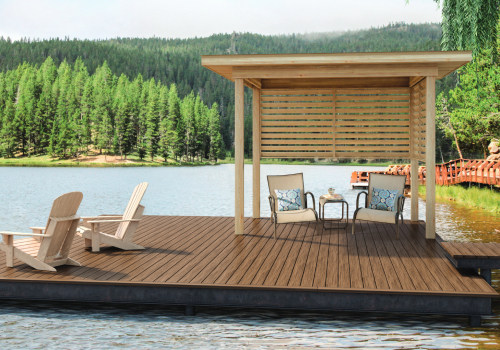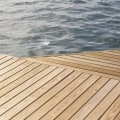Welcome to our comprehensive guide on boat lifts and jet ski ports! If you're a boat or jet ski owner, you know how important it is to have the right equipment to keep your watercrafts safe and easily accessible. That's where boat lifts and jet ski ports come in. In this article, we'll cover everything you need to know about these essential dock services and how they can enhance your boating experience. Whether you're a seasoned boater or just starting out, our detailed guide will provide valuable insights and information on boat lifts and jet ski ports.
So, let's dive in and explore the world of dock services together!If you're in the process of building or updating your dock, one of the most important aspects to consider is the type of boat lift and jet ski port you will need. These structures are essential for safely storing and protecting your boats and watercraft, and there are several options available on the market to choose from. In this article, we will discuss the different types of boat lifts and jet ski ports, as well as their pros and cons. First, let's start with floating docks. These are versatile structures that can be easily moved and adjusted to different water levels.
They are typically made of plastic or foam-filled materials, making them lightweight and easy to install. Floating docks are a great option for shallow waters or when a fixed dock is not feasible. However, they may not be as durable as fixed docks and can be more expensive. On the other hand, fixed docks are secured to the bottom of the water body and are more stable than floating docks. They can also be built higher off the water level, providing better protection for your boats and watercraft.
However, they require more extensive construction and may not be suitable for all types of water bodies. It's important to carefully consider your specific needs before deciding on a type of dock. Once you have chosen the type of dock that best suits your needs, it's time to start the construction process. Building a dock may seem like a daunting task, but with the right tools and knowledge, it can be done easily. First, you will need to secure the dock posts into the ground using concrete or metal anchors.
Next, attach the beams and joists to create a frame for the deck. Then, add the decking material on top, such as wood or composite boards. Maintaining your dock is crucial to ensure its longevity and safety. Regularly inspecting for any damage or wear and tear is important. This includes checking for loose or rotting boards, as well as any damage to the posts or beams.
It's also important to clean your dock regularly and remove any debris or algae that may cause slippery surfaces. Despite regular maintenance, repairs may be necessary for your dock. Common issues include cracked or damaged boards, broken hardware, or sinking sections. It's important to address these repairs promptly to prevent further damage. Depending on the severity of the issue, you may be able to fix it yourself or may need to hire a professional. Finally, let's talk about design ideas and materials for your dock.
When it comes to design, the possibilities are endless. You can choose a simple and functional design or go for a more elaborate and stylish one. Incorporating accessories such as benches, lights, and ladders can also enhance the functionality and appearance of your dock. As for materials, it's important to consider durability and maintenance when making your decision. Pressure-treated wood is a popular option as it is affordable and easy to work with.
However, it may require more maintenance over time. Composite materials are another option that offer low maintenance and durability, but can be more expensive. In conclusion, boat lifts and jet ski ports are essential components of a dock and require careful consideration when choosing the type and building process. Regular maintenance and prompt repairs can ensure your dock stays in top condition. And with the right design ideas and materials, you can create a functional and visually appealing dock that meets all your needs.
Common Repairs for Docks
Despite proper maintenance, repairs may be needed for your dock.Here's what you need to know.
Maintenance Tips for Your Dock
Proper maintenance is crucial for the longevity of your dock. Here are some important tips to keep in mind:Inspect regularlyIt's important to regularly inspect your dock for any signs of wear and tear. Look for any loose or damaged boards, rusted hardware, or cracks in the structure. Catching these issues early on can prevent further damage and save you money in the long run.Clean and treat wood
If your dock is made of wood, it's important to clean and treat it regularly.This helps prevent mold, mildew, and rot from damaging the wood. You can use a pressure washer to clean the surface and then apply a wood sealer to protect it.
Protect against marine growth
Marine growth, such as algae and barnacles, can attach to your dock and cause damage over time. To prevent this, consider installing a protective barrier or using a special paint that inhibits marine growth.Winterize your dock
If you live in an area with harsh winters, it's important to properly winterize your dock. This may include removing any equipment or furniture, securing loose items, and protecting the structure from ice damage.Hire a professional
If you're unsure about how to properly maintain your dock, don't hesitate to hire a professional.They can ensure that your dock stays in good condition and make any necessary repairs.
Building a Dock: Step-by-Step Guide
use HTML structure with boat lifts, jet ski ports, and dock only for main keywords and The construction process for a dock can seem overwhelming, especially if it's your first time. But don't worry, we've got you covered. In this step-by-step guide, we will break down the process into easy-to-follow steps, so you can create the perfect dock for your needs. Step 1: Determine the location and size of your dock. Consider factors such as water depth, shoreline, and accessibility. Step 2: Choose the right materials for your dock.The most common options include wood, aluminum, and composite materials. Step 3: Prepare the site for construction. Clear any debris or vegetation and make sure the area is level. Step 4: Construct the frame of the dock. This will typically involve building a series of parallel beams to support the deck. Step 5: Install the decking and railing. This will provide a stable surface for walking and add safety features to your dock. Step 6: Add any additional features such as boat lifts or jet ski ports. Step 7: Perform regular maintenance to ensure your dock stays in good condition. By following these steps, you'll have a beautiful and functional dock in no time! do not use "newline character"
Design Ideas for Your Dock
When it comes to designing your dock, the possibilities are endless.Whether you want a functional and practical design or a more visually appealing one, there are plenty of ideas to consider. Here are some design ideas to inspire you:1.Multi-Level DockA multi-level dock is a great option for those who have varying water levels or want different areas for different activities. This design allows for easy access to the water and provides different levels for sunbathing, fishing, or docking multiple boats.
2.Covered Dock
If you want to protect your boats and watercraft from the elements, a covered dock is the way to go. This design provides shade and shelter from rain or sun, making it perfect for longer stays on the water.3.Floating Dock
A floating dock is a versatile and low maintenance option that can adjust to changing water levels.It also provides a stable platform for activities like swimming, diving, or lounging.
4.Custom Shape Dock
If you have a unique shoreline or want a one-of-a-kind dock, consider a custom shape design. This allows you to create a dock that fits your specific needs and adds a personal touch to your property. These are just a few design ideas to get you started. Don't be afraid to get creative and think outside the box when designing your dock.Types of Boat Lifts and Jet Ski Ports
When it comes to boat lifts and jet ski ports, there are several options to consider. These include:- Cradle Lifts: These are the most common type of boat lift and use a cradle or sling to support the boat.
They are typically used for smaller boats and are great for shallow water.
- Piling Mount Lifts: These lifts use vertical poles, called pilings, to support the weight of the boat. They are ideal for deeper water and can accommodate larger boats.
- Floating Lifts: As the name suggests, these lifts are designed to float on the water's surface. They can be used for boats of all sizes and are great for fluctuating water levels.
- HydroHoist Lifts: These lifts use a series of air tanks to lift and lower the boat. They are a popular choice for larger boats and can also accommodate multiple boats at once.
- PWC Ports: For jet skis or other small watercraft, PWC ports are a great option.
They typically have a drive-on design for easy loading and unloading.
Recommended Materials for Dock Construction
When it comes to building a dock, choosing the right materials is crucial for its longevity and functionality. The type of materials you use will depend on the location, size, and purpose of your dock. Here are some recommended materials for dock construction: 1.Pressure-Treated Lumber: Pressure-treated lumber is a popular choice for dock construction due to its durability and resistance to rot and decay. It is also relatively affordable and easy to work with.However, it may not be the most environmentally friendly option due to the chemicals used in the treatment process.
2.Composite Decking:
Composite decking is a low-maintenance alternative to traditional wood decking. It is made from a combination of wood fibers and plastic, making it resistant to rot, mold, and insects. It is also eco-friendly and comes in a variety of colors and styles.3.Aluminum: Aluminum is a lightweight and strong material that is ideal for building docks in saltwater environments. It is resistant to corrosion and requires minimal maintenance. However, it can be more expensive than other materials.
4.Concrete:
If you are looking for a long-lasting and sturdy dock material, concrete may be the way to go.It can withstand heavy loads and harsh weather conditions, but it may not be the most visually appealing option. Ultimately, the best material for your dock will depend on your specific needs and budget. It's important to do your research and consult with professionals before making a decision. By choosing the right materials, you can ensure that your dock will provide a safe and enjoyable experience for years to come. In conclusion, boat lifts and jet ski ports are essential components of any dock.
By following our guide, you will have all the information you need to construct, install, maintain, and repair your dock. Remember to consider the type of dock, follow proper construction techniques, stay on top of maintenance, and use quality materials. With these tips, your dock will provide years of enjoyment for you and your watercraft.






